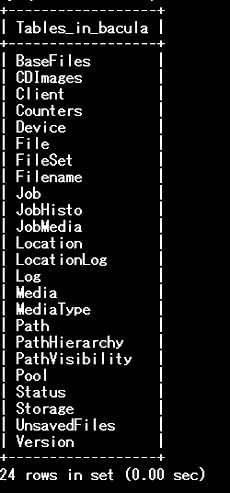|
Bacula - Configure Bacula Server#1
2011/07/18 |
|
Install Integrated Backup tool, Bacula.
This example shows to configure on the environment like follows.
(1) director.srv.world [10.0.0.60] Bacula Management Server - Director, Storage, Database Daemon (2) file01.srv.world [10.0.0.61] Bacula Client - File Daemon ( Backup Target )
Database is required on backends, so this example shows to use MySQL Server on Bacula Management Server.
It's possible to use PostgreSQL, SQLite, too.
|
|
| [1] | Install Director and Storage component on Bacula Management Server. |
|
[root@director ~]# yum -y install bacula-director-mysql bacula-storage-mysql bacula-console
|
| [2] | Create a database for Bacula. |
|
[root@director ~]#
/usr/libexec/bacula/grant_mysql_privileges -p Enter password: # root password for MySQL Privileges for user bacula granted on database bacula.
[root@director ~]#
/usr/libexec/bacula/create_mysql_database -p Enter password: # root password for MySQL Creation of bacula database succeeded.
[root@director ~]#
[root@director ~]# /usr/libexec/bacula/make_mysql_tables -p Enter password: # root password for MySQL Creation of Bacula MySQL tables succeeded. mysql -u root -p # connect to MySQL Enter password:
Welcome to the MySQL monitor. Commands end with ; or \g.
Your MySQL connection id is 10 Server version: 5.1.52 Source distribution
Copyright (c) 2000, 2010, Oracle and/or its affiliates. All rights reserved.
This software comes with ABSOLUTELY NO WARRANTY. This is free software, and you are welcome to modify and redistribute it under the GPL v2 license
Type 'help;' or '\h' for help. Type '\c' to clear the current input statement.
# set password for Bacula mysql> set password for bacula=password('password'); Query OK, 0 rows affected (0.00 sec) # set password for Bacula mysql> set password for bacula@localhost=password('password'); Query OK, 0 rows affected (0.00 sec) # make sure settings mysql> select user,host,password from mysql.user;  show databases; 
mysql>
Database changeduse bacula; Reading table information for completion of table and column names You can turn off this feature to get a quicker startup with -A mysql> show tables;  exit Bye |